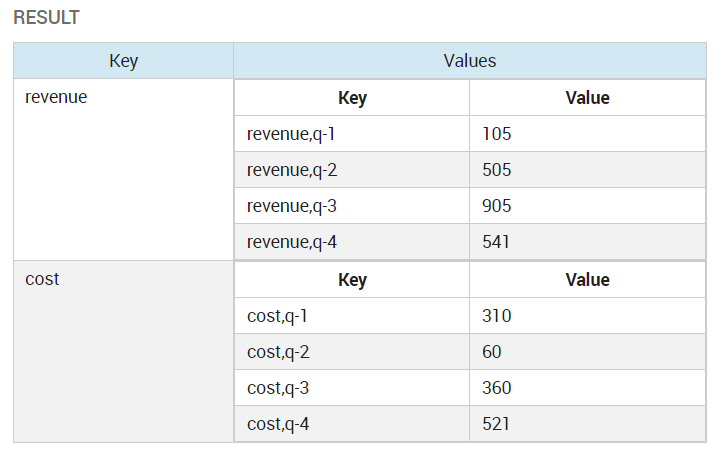Using VDL Action Group-By
vdl-action-group-by groups data by the key at a given position.
The vdl-action-group-by Action can be used in conjunction with other VDL Data Actions to get and aggregate entity data, filter it, and group it by a selected data key. The Actions can be used to dynamically fetch, save, group, filter, aggregate, label, and display data.
The vdl-action-group-by Action takes one or more keys and groups entity data according to those keys.
Data to be grouped must be formatted correctly. Each object in the data must have a key property. Key properties must be an array of primitives.
Group By single dimension
The vdl-action-group-by Action creates a new object (group) for each key. The object contains two properties, the key, and an array containing all of the rows with the unique key at the designated set position.
- set-position 0:
['revenue', 'cost'] - set-position 1:
['q-1', 'q-2', 'q-3', 'q-4']
<script>
const data = [
{key: ['revenue', 'q-1'], value: 105},
{key: ['revenue', 'q-2'], value: 505},
{key: ['revenue', 'q-3'], value: 905},
{key: ['revenue', 'q-4'], value: 541},
{key: ['cost', 'q-1'], value: 310},
{key: ['cost', 'q-2'], value: 60},
{key: ['cost', 'q-3'], value: 360},
{key: ['cost', 'q-4'], value: 521}
];
</script>
<vdl-var name="exampleData" value="=[]"></vdl-var>
<vdl-action-group name="example">
<vdl-action-group-by data="=data" set-position="=value"></vdl-action-group-by>
<vdl-action-set-var var="exampleData"></vdl-action-set-var>
</vdl-action-group>
<vdl-button label="Group source data by set-position 0" value="0" vdl-event="click:actions.example"></vdl-button>
<vdl-button label="Group source data by set-position 1" value="1" vdl-event="click:actions.example"></vdl-button>Data is returned as an array of objects. Each object has a key and values property. The key will be a primitive and the values property will be an array containing the data objects for that group.
Group By multiple dimensions
The vdl-action-group-by Action can also be used to group data by multiple keys. When grouping by multiple keys the object will contain an array of the keys used to group the data, and an array containing all the rows with the unique key at the designated set-position.
<vdl-action-group-by data="=vars.example1Data" set-position="=[0,1]"></vdl-action-group-by>Using default keys
You can ensure that the results of vdl-action-group-by will always contain specific keyed groups or objects by using the default-keys attribute. Keys that are passed to vdl-action-group-by will always be displayed, but default-keys can be used to force a key to be displayed even if there are no data rows containing that key to be displayed.
If keys passed in default-keys exist in the data, they will not be duplicated.
<vdl-action-group-by data="=example2Data" set-position="1" default-keys="=[1,2,3,4,5]"></vdl-action-group-by>© 2001-2024 Fair Isaac Corporation. All rights reserved. This documentation is the property of Fair Isaac Corporation (“FICO”). Receipt or possession of this documentation does not convey rights to disclose, reproduce, make derivative works, use, or allow others to use it except solely for internal evaluation purposes to determine whether to purchase a license to the software described in this documentation, or as otherwise set forth in a written software license agreement between you and FICO (or a FICO affiliate). Use of this documentation and the software described in it must conform strictly to the foregoing permitted uses, and no other use is permitted.

